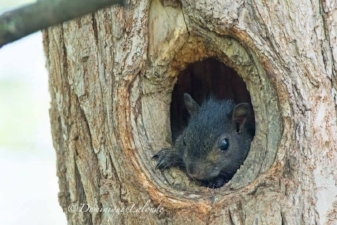Beyond Your Backyard. 🍃 "Animals and Their Hiding Places." 🐰
Gray Squirrel nest with juvenile peeking out. Photo by Dominique Lalonde
Cottontail Rabbit nest.
Kimberly J. Epp.
Recently a female Cottontail Rabbit was brought in to Moose Jaw's "Wild and Cared Free Wildlife Rehabilitation". She was a lactating female, shot cruelly and needlessly in the spine with a bb gun. The community searched for her kits, but they were never found. Unfortunately, the mother didn't make it, either. If you see any children shooting at animals with bb guns, please call your local police. Animals are quite good at hiding their nests, and most people wouldn't even notice a bunny nest in their yard. But with lawn cutting, brush trimming, etc. you should be aware of the creatures that live amongst us.
Cottontail Rabbit nest
The Cottontail Rabbit doe makes a nest in a shallow hole in the ground and lines it with plants and grasses. She then adds fur plucked from her own body to make the nest extra warm for her babies (kits). Rabbits are born naked and helpless, while hare young (leverets) can hop soon after birth. During the first two weeks, the rabbit doe will leave the kits alone, except when it's time to nurse - so don't assume a nest of babies is abandoned. The majority of baby animals brought in to rehabbers aren't even orphaned.
When the rabbit doe approaches the nest, she is careful to do so in a zig zag pattern - and then leaps the last few feet in order not to leave a trail. In the nest, the babies are safe from most wild predators. But their open nursery can sometimes place them in danger by the hands of humans. So please, be aware and leave them there. Mother is always within earshot. Prior to mowing, look for patches and clumps of dead grass. Do not mow over a suspected rabbit's nest. Simply leave it there. If you simply cannot, please call a wildlife rehabber. Never remove the young on your own.
A look inside a Red Squirrel nest with the mother and her helpless, newborn babies. Photo credit unknown
After mating, a female squirrel prepares a home in a tree den for her babies. If no tree holes are available, she will build a drey (a leaf nest), although more security and protection from the elements is provided in a tree hollow. The nursery is furnished and lined with strips of bark and leaves to make a soft warm home for her babies. The baby squirrels are born tiny, pink and naked. Mama is very protective over her nest, and will chase away any intruders - that includes even the father. Sometimes she will move them to a new nest if threatened.
Hummingbird nest
White-Tailed Deer and Mule Deer does lick their fawns scentless, then hide them in an area where they can blend in with their surroundings - and they are not to move at all. With about 300 white spots, predators think these are simply spots of sunlight shining on the ground. Once the doe hides her baby in some brush and grasses, she feeds or rests nearby. But she is never far off, and ready to fight off any predators that get too close. Never move a fawn. The fawn has a better chance of survival being cared for by its mother.
Some other points to mention. Before you trim any bushes or low evergreen branches, check for hummingbird nests. See the photo below for scale. They are very camouflaged and tiny, but just because we can't see them doesn't mean they aren't there. Also, never burn a brush pile without first checking it for raccoon nests. Brush piles make popular spots for nesting raccoons. By simply being more aware of the other species that may share your yard at this time of year, you can do more to ensure they are safe and free from harm.
Remember, if you care leave them there. When in doubt, give a rehabber a shout.
One of this year's new fawns. Photo by Doug DeDecker.One of this year's new fawns. Photo by Doug DeDecker.






